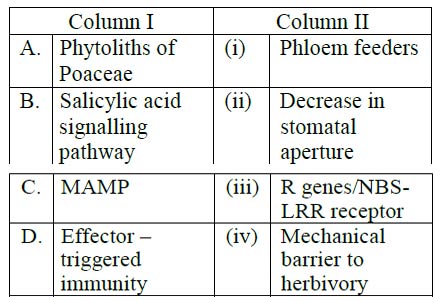Dear Students,
Welcome to Plant Physiology MCQ-06. This MCQ set consists of Advanced (PG Level) Plant Physiology CSIR NET Questions with Answer Key taken from the previous year question papers of CSIR JRF NET Life Sciences Examination. These questions can be used for the preparation of Competitive examinations in Biology / Life Sciences such as CSIR JRF NET, ICMR JRF, DBT BET JRF, GATE and other University Ph.D Entrance Examinations.
You may also like: Plant Physiology Notes | Plant Physiology PPT
(1). A researcher developed quadruple mutant that disrupted the function of all phytochrome interacting factor (PIF) family members. The following hypotheses were proposed regarding the phenotype of the mutant plants when grown in dark:
(A). Plants would show short hypocotyls
(B). Plants would be etiolated
(C). Light induced genes would be activated
(D). The cotyledons would be open
Which one of the following combinations of the above hypotheses is correct? (CSIR_2017_II)
Advanced Plant Physiology MCQ Part 1 | Part 3
(a). A, B and C
(b). A, B and D
(c). A, C and D
(d). B, C and D
Ans. (d)
(2). The photon intensity captured by green plants is used in the following processes:
(i) Photosynthesis
(ii) Generation of heat
(iii) Production of toxic products such as superoxide, singlet oxygen etc.
(iv) Damage to D1 protein of PSII
Based on the above facts, photo-inhibition will happen when the (CSIR_2017_II)
(a). Entire photon intensity is used for photosynthesis
(b). Excess photon intensity is completely used for heat generation
(c). Excess photon intensity is used for heat generation and formation of toxic products
(d). Excess photon intensity leads to the damage of D1 protein
Ans. (d)
(3). With reference to plant biotic interactions, match the terms of Column I with the most appropriate term of Column II (CSIR_2017_II)

(a). A – (ii), B – (iv), C – (i), D – (iii)
(b). A – (iii), B – (i), C – (ii), D – (iv)
(c). A – (iv), B – (ii), C – (iii), D – (i)
(d). A – (iv), B – (i), C – (ii), D – (iii)
Ans. (d).
(4). Transgenic tobacco plants over-expressing isopentenyl transferase (IPT) under the control of promoter region of Senescence- Associated Receptor kinase (PSARK) were exposed to drought for 15 days followed by re-watering for 7 days. The following hypotheses were proposed regarding changes in the transgenic plants at the end of 7 days of re-watering:
(A). The plants would be wilted and fail to survive.
(B). The plants would be healthy and survive.
(C). The plants would show higher production of cytokinin compared to wild type plants.
(D). The plants would show higher production of absicic acid compared to wild type plants.
Which one of the following combinations of the above hypotheses is correct? (CSIR_2017_II)
(a). A and C
(b). A and D
(c). B and C
(d). B and D
Ans. (c)
(5). In terpene biosynthesis pathways, three acetyl-CoA are joined together stepwise to form mevalonic acid. Which one of the following three steps is required by mevalonic acid to form isopentenyl diphosphate or isopentenyl pyrophosphate (IPP)? (CSIR_2015_I)
(a). Pyrophosphorylation, decarboxylation and dehydration
(b). Alkylation, Pyrophosphorylation and decarboxylation
(c). Methylation, dehydration and alkylation
(d). Phosphorylation, carboxylation and methylation
Ans. (a)
(6). Following segments are related to oxidative phosphorylation
(A). Redox reactions of electron transport chain coupled with ATP synthesis are collectively called oxidative phosphorylation
(B). Three major process;: Glycolysis, oxidative pentose phosphate pathway and citric acid cycle are related to oxidative phosphorylation
(C). Election transport proteins are bound to outer of the two mitochondrial membranes
(D). In the electron transport chain electrons are transferred to oxygen from NADH.
Which one of the following combinations of above statements is correct? (CSIR_2015_I)
(a). (A) and (D)
(b). (B) and (C)
(c). (C) and (D)
(d). (A) and (C)
Ans. (a).
(7). Rhizobial genes that participate in legume nodule formation are called nodulation (nod) gens. The nodD-encoded protein: (CSIR_2016_I)
(a). Is an acetyl transferase that adds a fatty acyl chain to the Nod factor.
(b). Binds to the nod box and induces transcription of all nod genes.
(c). Catalyzes the linkage of N-acetyl glucosamine residues.
(d). Influences the host specificity of Rhizobium.
Ans. (b)
(8). Which one of the following plant hormones use the two-component histidine kinase receptor system for signal transduction? (CSIR_2016_I)
(a). Auxin
(b). Gibberellin
(c). Cytokinin
(d). Abscisic acid
Ans. (c)
(9). Which one of the following photoreceptors plays a role in day length perception and circadian rhythms? (CSIR_2016_I)
(a). Zeitlupe family
(b). Cryptochromes
(c). Phototropins
(d). UV Resistance locus 8
Ans. (a)
(10). Ribulose bisphosphate carboxylase (Rubisco) catalyzes both carboxylation and oxygenation of ribulose-1, 5-bisphosphate. The latter reaction initiates a physiological process known as ‘photorespiration’. The following are certain statements on photorespiration:
(A). The active sites on Rubisco for carboxylation and oxygenation are different.
(B). One of the steps in photorespiration is conversion of glycine to serine.
(C). 50% of carbon lost in chloroplast due to oxygenation is recovered through photo- respiration.
(D). The pathway of photorespiration involves chloroplast, peroxisome and mitochondria.
Which one of the following combinations of above statements is correct? (CSIR_2016_I)
(a). A and C
(b). A and D
(c). B and D
(d). C and D
Ans. (c)
